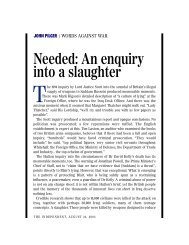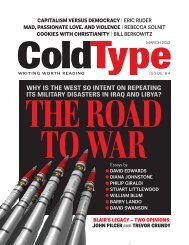Create successful ePaper yourself
Turn your PDF publications into a flip-book with our unique Google optimized e-Paper software.
64<br />
revenues. That’s the division, by the way, that I worked in and<br />
that Lloyd Blankfein managed on his way up the Goldman<br />
totem pole. (It’s also the division that would stand to gain the<br />
most if Waxman’s cap-and-trade bill passes.)<br />
Of course, Goldman did pay back the US government which<br />
made a profit on the deal but at the same time, supposedly,<br />
lost any possible leverage on the firm according to President<br />
Obama on PBS, “Now, there are some companies, like Goldman<br />
Sachs, that have paid the money back and that means<br />
that we don’t have the same kind of levers on them that we<br />
might have.”<br />
Why did Goldman pay even more than was expected?<br />
David Reilly of Bloomberg News explained they were worried<br />
about mounting public hostility. “The danger for Goldman is<br />
that it becomes a focal point for populist bailout ire, leading<br />
the government to take a tougher stance on regulation,” he<br />
wrote. “Treating too-big-to-fail institutions as financial utilities,<br />
for example, would curtail Goldman’s ability to generate<br />
returns on equity in excess of 20 percent.”<br />
The hostility to Goldman can be found plastered all over the<br />
Internet. One example, a post by Ilarg on the AutomaticEarth<br />
website: “Two consecutive US governments, both with economic<br />
teams led by “alumni” from Goldman Sachs and other<br />
Wall Street firms, have put $23.7 trillion in US taxpayer money<br />
at risk to rescue their former – and often future – employers.<br />
This has bought the main banks the chance to be left intact<br />
for a while longer (but only for a while), because the only thing<br />
people now can see is the veil the banks hide behind, the most<br />
costly layer of veneer in history.”<br />
The truth is, the government didn’t have many levers on<br />
Goldman in the first place. It seems as if Goldman was the<br />
dominant party in that relationship.<br />
Financial analyst Reggie Middleton offers more details in<br />
his Boom Bust Blog:
















